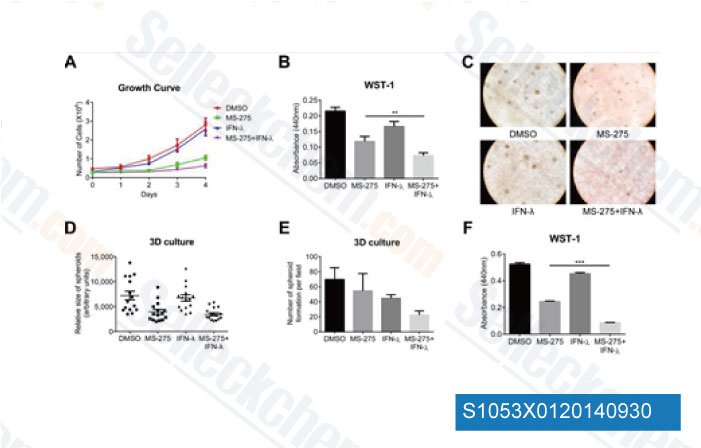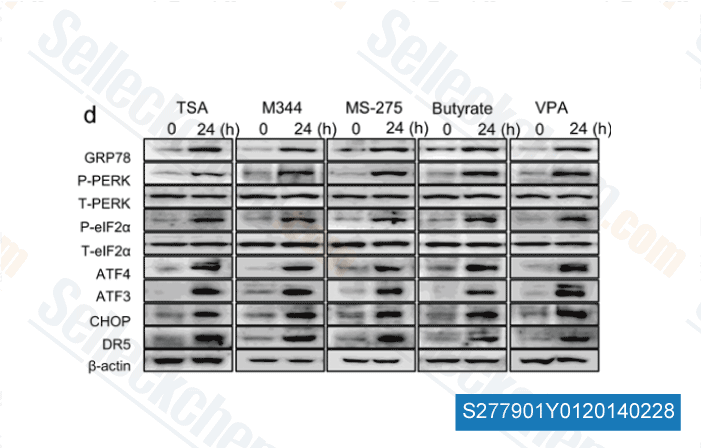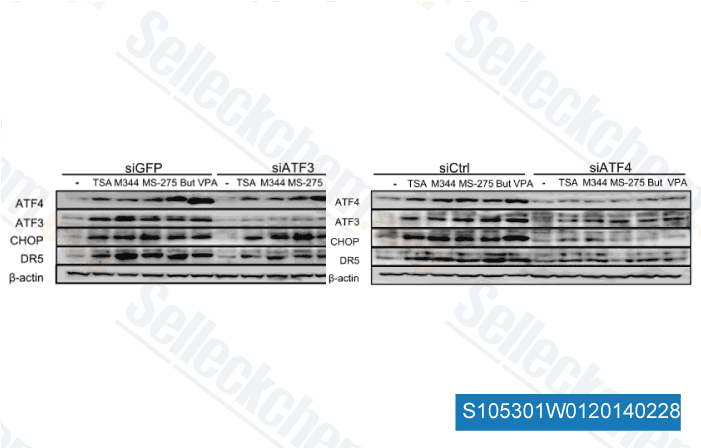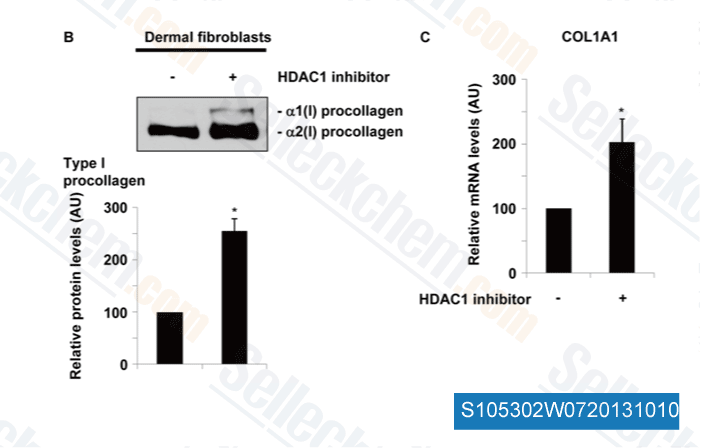|
Toll Free: (877) 796-6397 -- USA and Canada only -- |
Fax: +1-832-582-8590 Orders: +1-832-582-8158 |
Tech Support: +1-832-582-8158 Ext:3 Please provide your Order Number in the email. |
Technical Data
| Formula | C21H20N4O3 |
||||||||||
| Molecular Weight | 376.41 | CAS No. | 209783-80-2 | ||||||||
| Solubility (25°C)* | In vitro | DMSO | 75 mg/mL (199.25 mM) | ||||||||
| Water | Insoluble | ||||||||||
| Ethanol | Insoluble | ||||||||||
| In vivo (Add solvents to the product individually and in order) |
|
||||||||||
|
* <1 mg/ml means slightly soluble or insoluble. * Please note that Selleck tests the solubility of all compounds in-house, and the actual solubility may differ slightly from published values. This is normal and is due to slight batch-to-batch variations. * Room temperature shipping (Stability testing shows this product can be shipped without any cooling measures.) |
|||||||||||
Preparing Stock Solutions
Biological Activity
| Description | Entinostat (MS-275, SNDX-275) strongly inhibits HDAC1 and HDAC3 with IC50 of 0.51 μM and 1.7 μM in cell-free assays, compared with HDACs 4, 6, 8, and 10. Entinostat induces autophagy and apoptosis. Phase 3. | ||||
|---|---|---|---|---|---|
| Targets |
|
||||
| In vitro | MS-275 shows inhibitory to HDACs by 2'-amino group. MS-275 induces accumulation of p21WAF1/CIP1 and gelsolin in K562 cell. MS-275 could reduce S-phase cells and induce G1-phase cells in A2780 cell. MS-275 inhibits the proliferation of human tumor cell lines including A2780, Calu-3, HL-60, K562, St-4, HT-29, KB-3-1, Capan-1, 4-1St and HCT-15 with IC50 from 41.5 nM to 4.71 μM, which due to HAD-inhibition. [1] MS-275 is not sensitive to other HDACs (4, 6, 8 and 10) with IC50 about/above 100 μM. [2] MS-275 shows great inhibition to human leukemia and lymphoma cells, including U937, HL-60, K562, and Jurkat. MS-275 also decreases expression of cyclin D1 and the antiapoptotic proteins Mcl-1 and XIAP. [3] | ||||
| In vivo | MS-275 exhibits great antitumor activity against human tumor xenografts except HCT-15 at 49 mg/kg. [1] MS-275 demonstrates promising therapeutic potential in both solid and hematologic malignancies, as well as regulation of physiologic and aberrant gene expression. [4] MS-275, combination with IL-2, has great antitumor activity to renal cell carcinoma xenograft model, which due to decreased T regulatory cells and increased splenocytes. [5] |
Protocol (from reference)
| Kinase Assay: |
|
|---|---|
| Cell Assay: |
|
| Animal Study: |
|
References
|
Customer Product Validation

-
Data from [ PLoS Biol , 2014 , 12, e1001758 ]

-
Data from [ Biochem Biophys Res Commun , 2014 , 10.1016/j.bbrc.2014.01.184 ]

-
Data from [ Biochem Biophys Res Commun , 2014 , 10.1016/j.bbrc.2014.01.184 ]

-
Data from [ PLoS One , 2013 , 8, e74930 ]
Selleck's Entinostat (MS-275) Has Been Cited by 486 Publications
| Reprogramming aerobic metabolism mitigates Streptococcus pyogenes tissue damage in a mouse necrotizing skin infection model [ Nat Commun, 2025, 16(1):2559] | PubMed: 40089471 |
| PROX1 is an early driver of lineage plasticity in prostate cancer [ J Clin Invest, 2025, 135(11)e187490] | PubMed: 40454483 |
| Early growth response 1 as a key regulator of PD-L1 expression and immune evasion in extranodal NK/T-cell lymphoma [ Blood Cancer J, 2025, 15(1):108] | PubMed: 40514360 |
| HDAC1 acts as a tumor suppressor in ALK-positive anaplastic large cell lymphoma: implications for HDAC inhibitor therapy [ Leukemia, 2025, 10.1038/s41375-025-02584-9] | PubMed: 40175628 |
| Stochastic demethylation and redundant epigenetic suppressive mechanisms generate highly heterogeneous responses to pharmacological DNA methyltransferase inhibition [ J Exp Clin Cancer Res, 2025, 44(1):21] | PubMed: 39844304 |
| Dual targeting of CDK6 and LSD1 is synergistic and overcomes differentiation blockade in AML [ EMBO Mol Med, 2025, 10.1038/s44321-025-00296-2] | PubMed: 40883610 |
| Engineering a multilayered 3D stromal barrier model for quantitative analysis of T cell infiltration and cytotoxicity [ Acta Biomater, 2025, S1742-7061(25)00677-4] | PubMed: 40939760 |
| Epigenomic regulation of stemness contributes to the low immunogenicity of the most mutated human cancer [ Cell Rep, 2025, S2211-1247(25)00332-8] | PubMed: 40250424 |
| Pharmacologically induced proteolysis of histone deacetylase-6 attenuates influenza virus replication despite limited anti-tumor effects [ Life Sci, 2025, 363:123401] | PubMed: 39814129 |
| HDAC1-3 inhibition triggers NEDD4-mediated CCR2 downregulation and attenuates immunosuppression in myeloid-derived suppressor cells [ Cancer Immunol Immunother, 2025, 74(3):81] | PubMed: 39891718 |
RETURN POLICY
Selleck Chemical’s Unconditional Return Policy ensures a smooth online shopping experience for our customers. If you are in any way unsatisfied with your purchase, you may return any item(s) within 7 days of receiving it. In the event of product quality issues, either protocol related or product related problems, you may return any item(s) within 365 days from the original purchase date. Please follow the instructions below when returning products.
SHIPPING AND STORAGE
Selleck products are transported at room temperature. If you receive the product at room temperature, please rest assured, the Selleck Quality Inspection Department has conducted experiments to verify that the normal temperature placement of one month will not affect the biological activity of powder products. After collecting, please store the product according to the requirements described in the datasheet. Most Selleck products are stable under the recommended conditions.
NOT FOR HUMAN, VETERINARY DIAGNOSTIC OR THERAPEUTIC USE.
